A local’s guide to help you explore famous places and hidden gems near the Colosseum, experience real Rome and make the most of the city.
The Roman Colosseum is located in one of the most interesting areas of Rome, between the historic district of Monti, Celio and Historic center.
Around it you have invaluable archaeologic sites, stunning churches, art galleries and a plethora of restaurants, shops and entertainment venues to suit adults and kids alike.
It’s a fantastic areas to explore, very Romand and authentic.
Yet, despite the variety and richness of this area, the misconceptions that the Colosseum is ‘far from everything’ and that ‘there is nothing to do around it’ is alive and well and I regularly find myself having to reassure visitors this is indeed one of the best areas to stay in Rome.
Fast tourism has manufactured the ideas that in Rome is basically made of Piazza Navona area (‘everything’) and two stand alone attractions in the middle of nowhere: the Colosseum and the Vatican. But nothing is further from the truth!
While some of the main attractions are in indeed in the Navona area, the stunning geographical center of Rome, the city has much more to offer that the usual 3 / 4 places that make up the ‘Rome muse see sites’ and the area of the Colosseum is a perfect example of the city’s variety and richness.
Today, I share my selection of the best things do in the area, including top sites and hidden gems near the Colosseum I am sure you’ll love!
I am from Rome and the Colosseum area is one a visit over and over again as it has endless attractions, great charm and the quintessential Rome feel. I hope you love it!
(Hidden gems in the) Roman Forum and Palatine Hill
The Roman Forum and Palatine Hill are just in front of the Colosseum; they are very well known places, and yet many visitors skip them and even those who do not, often miss some of their most unique spots!
The Palatine and Forum are where you see the place where Rome was born, where you walk along to footsteps of ancient Romans, and where you get a sense of the many centuries of history of the city, and the area is so beautiful!

You can visit these areas with or without a tour and as quickly or slowly as you want but no matter how you do it, I recommend you seek out a few special areas that many tourists miss: Santa Maria Antiqua, the so called Temple of Romulus and Vigna Barberini, a small vineyard inside the forum most people never see!
These are lesser know, lesser visited areas of the Forum and Palatine that add to the experience and enjoyment of your visit.
Tis can read here >> my guide to the Roman Forum and Palatine Hill
The Imperial Fora, Forum of Trajan and Trajan’s Column
On the opposite side of the road from the Roman Forum you find additional Fora, each belonging to a different emperor.
The most impressive of all is the Forum or Trajan, worth visiting both for the Forum itself, the stunning exhibition that explains the expansion of the empire in Trajan’s times and the incredible Trajan’s Column, the so called ‘first film in history’ (follow the link to learn why!)
If you love history, this is one of the most beautiful and informative archaeological sites in Rome.
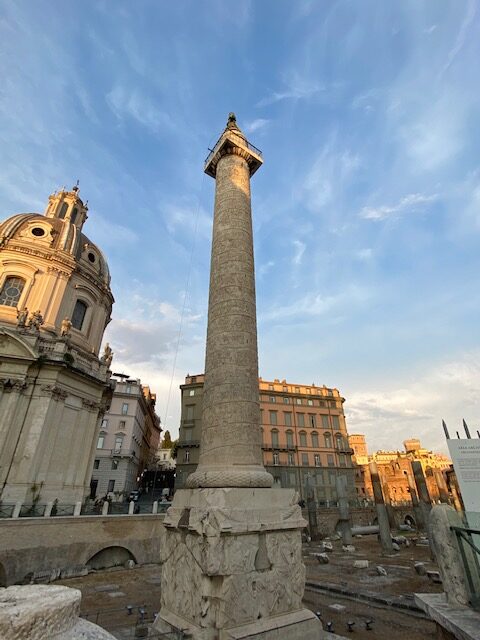
Domus Aurea (archaeological site)
In front of the Colosseum, inside of what now looks like a green hill, lies one of the most fascinating and significant archaeological sites in Rome: the ancient Palace of Emperor Nero, the Domus Aurea.
The Domus Areas was the palatial home of Nero, an architectural feat of stunning chambers, patios, gardens and entertaining areas that contemporary sources report as so magnificent ‘nothing of the sort had ever been seen before’.
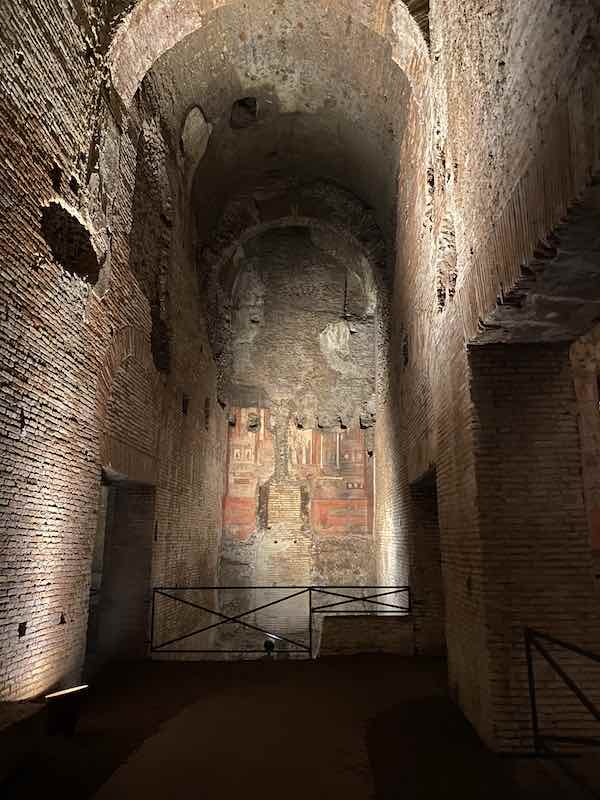
However, this incredible construction had a short lifespan: as soon as Nero died, his home was appropriated and, literally, buried under tons of soil, erased from sight and memory.
Nowadays, the Domus is still underground but it open to visitors and it is an I incredible site.
Visits are by guided tour only and they should you the house as it is now but also as it was then, with the aid of video projection and virtual reality headsets.
This is an incredible sites to visit and one I strongly recommend to include into your itinerary. You can find here >>> my guide to the Domus Aurea.
The Oppian Hill (Colle Oppio)
The Oppian Hill (Colle Oppio) is the hill in front of the Colosseum, where you also find the entrance to the Domus Aurea.
The hill is easy to reach and visit and hides some lovely corner: a pretty park with lovely Colosseum views and an additional pretty viewing terrace, recently opened, perfect for photos!


Case Romane del Celio (archaeological site)
Just beside the Colosseum, on the Caelian Hill, you find a real hidden gem, a place most visitors never see: the Roman houses of the Caelian Hill (Case Romane del Celio).
Case Romane del Celio is an architectural complex of several ancient houses that you can enter and explore with the aid of an audio guide.
The site is stunning as you can see the different spaces and decorative frescoes and adds a layer of understanding about what ancient Roman life must have been like that complement greatly what we learn from the more official sites such as the colosseum and the forum.
The walk to the case Romane is itself beautiful: take the time to stop and visit the church above them a da admire the brick arches that lead you back to the Palatine area. You can find my guide here.

Piazza degli zingari / Via Urbana / Via Panisperna
The area cose other colosseum is a delight of cobbled streets and secret corners, so much so that pinpointing specific spots is hard as the way to these spots is often as beautiful as the spots themselves!
To enjoy the best of this area, I recommend to devote to it a full morning or afternoon.
Make sure you walk along via Urbana and its vintage shops, Via dei Serpenti and its restaurants, let Via del Colosseo and Piazza deli Zingari surprise you but more in general, allow yourself to get ‘lost’ here: you’ll immerse yourself in tie most roman atmosphere you can ever get.
You can find here >>> my guide to the Monti district

Santo Stefano Rotondo
The church of Santo Stefano Rotondo is one of the most peculiar churches in Rome and one of the hidden gems near the Colosseum on the Caelian Hill, the hill at the back of the Colosseum, towards Caracalla.
The church is peculiar on a couple of account: first of all, the church church is round, a characteristic that is not unique in Rome but definitely not common either, with the altar in the middle!
The other peculiarity is that the church as very gory frescoes all around it, depicting scenes of martyrdom: the frescos are rather disturbing but they do dat from the 1200s so they have an interest in terms of history of art.

Access to the church is free and you do not need a tour.
My favorite part of the church is the garden in front, which is pretty and very roman: I do recommend to come here to immerse yourself in a quite and rather unique place!
Villa Celimontana
Villa Celimontana is a very pretty park o tops of the Caelian hill where you can have a stroll or a rest whenever tired of the hustle and bustle of Rome: it’s a wonderful oasis of peace!
The villa hosts jazz concerts in summer too, and becomes a popular destination for summer nights.
San Clemente (church)
The church of san clemente is one of the most fascinating in Rome Located only a short walk from the colosseum, the church may seem unremarkable form the outside but hides a secret.
Inside, you can see it is not one building but several buildings, over time but one on top the other, each preserving memories of the historic area fo their construction!
Rome is all made of layers, with the most ancient parts of the city buried beneath the news ones, that have either reused or replaced who was here before and San Clemente one so the best places where to experience this stratigraphy.
The church is open by reservation only. Official site here.
Santi Quattro Coronati (Church)
The church of santi quarto coronati is one of the most beautiful ancient churches in Rome, and a fantastic examples of Carolingian architecture in rome.

The church dates from the V century AD but gained a cloister, tower and the monastic accommodation in the early years of century XI.
The church is free to visit and worth the short yet steep walk up the hill to reach it.
Only part the church as freely accessible: for other, you need to maker special arrangements with the monastery. You can find info here
Palazzo Merulana
Palazzo Merualana isa stunning elegant building on Via Merulana recently transformed into art gallery and cultural space.
The palazzo has a permanent and temporary exhibitions and has notable work from the XX century artists such as balla, De chirico, Sironi and more.
The palazzo is off the beaten tack and a swonderuflart space to explore and enjoy. You can find info here.
Arch of Gallieno
The Arch of Gallieno is a peculiar, beautiful arch hidden on a side street in Monti and one of Rome’s most hidden gems near the Colosseum that makes local say you can spend a lifetime in Rome and not be done: even Romans are often surprised to learn it is here!

The arch is now part of the city so you do not need a guide ot a tour to see it: the arch is not a triumphal arch, but rather and ancient gateway into the city, only later dedicated to emperor Gallienus.
The arch is just beside the Church of of Santi Vito and Modesto and is a wonderful example on how modern Rome still maintains and develops around its most ancient past.
Museum of Illusions
The Museum of Illusions is a really fun permanent exhibition for kids and adults with installations that trick the eye into seeing things that are not quite what they seem (optical illusions).
While not particularly Roman as such, it is a fun place to visit and a great way to break up sightseeing if you have kids especially.
You can read here my review of the Museum of Illusions from when I went with the kids.
Santa Prassede
The church of Santa Prassede is one of the most beautiful and significant in Rome, yet it is very much a hidden gem as very few tourist ever come here, despite it being close to the Colosseum and in Monti, a popular area for people to sta.
The church of santa passed is one of the rare examples in Rome of Byzantine style and has a some of the most remarkable mosaics in Rome.
You can visit it in your time, no tour needed. You can find info here.

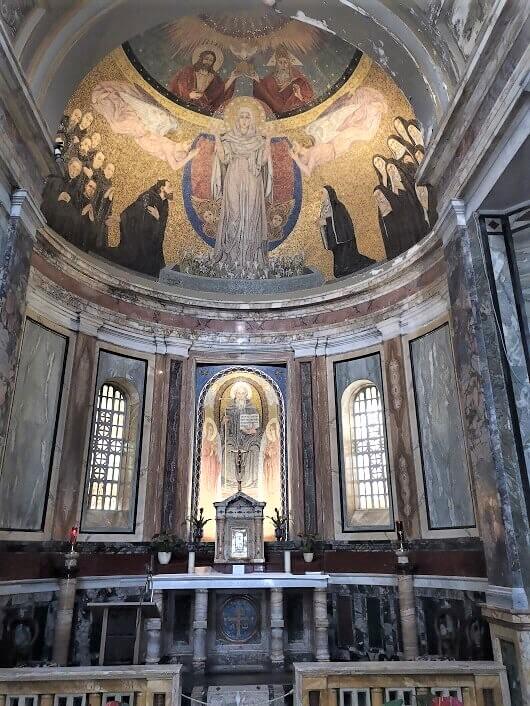
Santa Maria Maggiore
The church or Santa Maria maggiore is one the major Papal Basilicas in Rome and a significant place to see for Catholic visitors but also lovers of art.
The church has stunning mosaics, several Papal tombs and, lately, it opened its top terrace to the public, making it a a stunning place fo where to admire views over Rome. You can read our essential guide here.
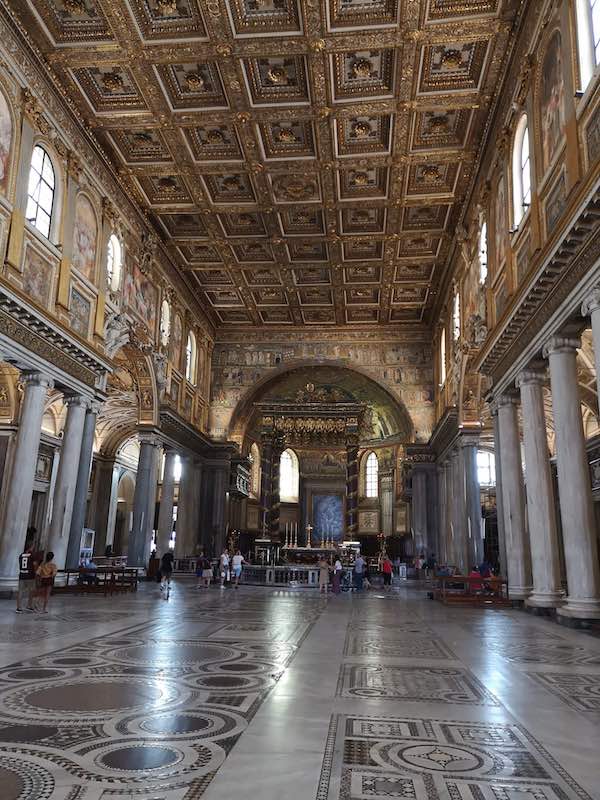

San Pietro in Vincoli (St Peter in chain)
The Church of San Pietro in Vincoli (St Peter in Chains) is one of the easiest and most rewarding Rome hidden gems near the Colosseum to visit.
It is beautiful church, it has great religious importance for Christians since it is believed to hold the remains of the chains of St Peter and it also has a stunning Moses by Michelangelo, which means it is one of the most important places in Rome for sculpture and art lovers.
The church is free to visit an to do not need a tour.
Top tip: as you walk here, see if you can peek into the facility of engineering just beside the church.
The university occupies and old palazzo and has a stunning cloister worth noticing!
Find here >> my essential guide to the Church of St Peter in Chains
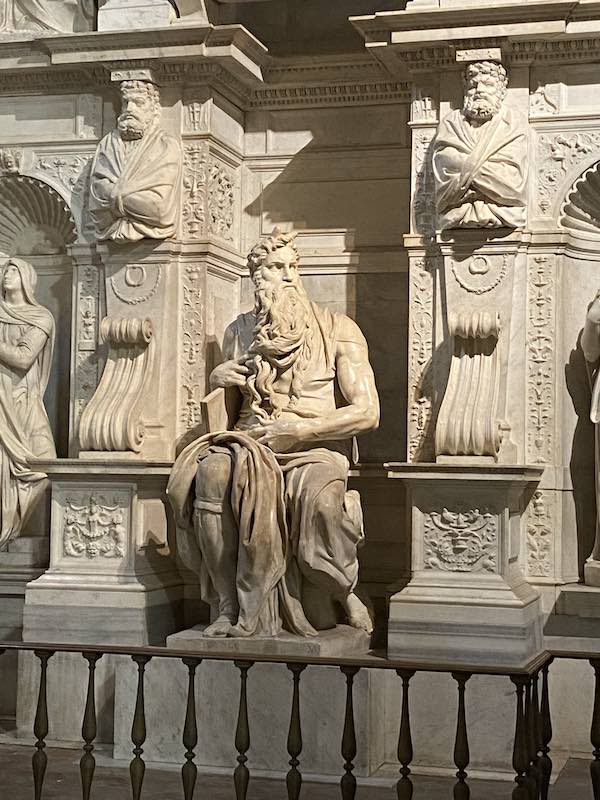

Scalinata dei Borgia
Scalinata dei Borgia is a peculiar stairway connecting San Pietro in vincoli with via Cavour and its’ a beloved spot for photographers, since it has climbing plants and red bricks that make it atmospheric and unique.
The salta is popular yet run down an it is not usual to see homeless people sleeping here but it is nonetheless worth seeing and a a true roman corner.
Capitoline hIll
The Capitoline hill is one of the sever hills of Rome and only a short walk for the colosseum.
The hill is rich of thins to see and you an easily spend a long morning here.
The Capitoline Museums have some the most significant collections of ancient Roman art in the city and are part of the roman national museum, among the best in Rome.

If you prefer not to visit a museum or want a more unusual experience, you can still enjoy the view of the stunning piazza del Campidoglio but Michelangelo and sweeping views of the Forum (free) and visit the stunning church of Ara Coeli: enter form the back of the church on the Palatine Hill and exit from the front to catch the most impressive views over Rome.
You can find here >>> my guide to the Capitoline Hill.
Vittoriano
The Vittoriano is on of the most distinctive monuments in Rome and one you’ll pass over and over again especially if staying in this area.

The monument is originally dedicated to the first king of Italy but it is now more generally a symbol of National Unity: inside, you find an interesting museum but you can also just enjoy the views form the free terraces. Worth climbing!
While not a hidden gem, not many realise you can walk up here for free!
Fun fact: the equestrian statue is so big, when the monument was finished, constructors dignitaries had a celebratory rotary inside it!
You can read here >> all you need to know about Rome’s Vittoriano.
Circo Massimo
Circo Massimo is the ancient chariot race stadium of Rome and now a large archaeological site just beside the Colosseum.
The Circus may not seem very impressive at fist glance, but if you are here when the virtual reality tours are available (Circo Massimo Experience) is a great place to explore for an hour or so.
Even if not, it is wore walking to the opposed side of it and catch a view of the palatine hill from below it’s stunning!

Roseto Comunale
Not far from the colosseum, just behind circus Maximus, lies the Aventine Hill, one of the famous seven hills of rome and, on is slope, the lovely Roseto Comunale, Rome’s rose garden.
Entrance is free and, during rose flowering season, a delightful place for a walk and a rest. You can find here my guide to Rome’s Rose garden and why it is one of my favorite hidden gems close to the Colosseum.
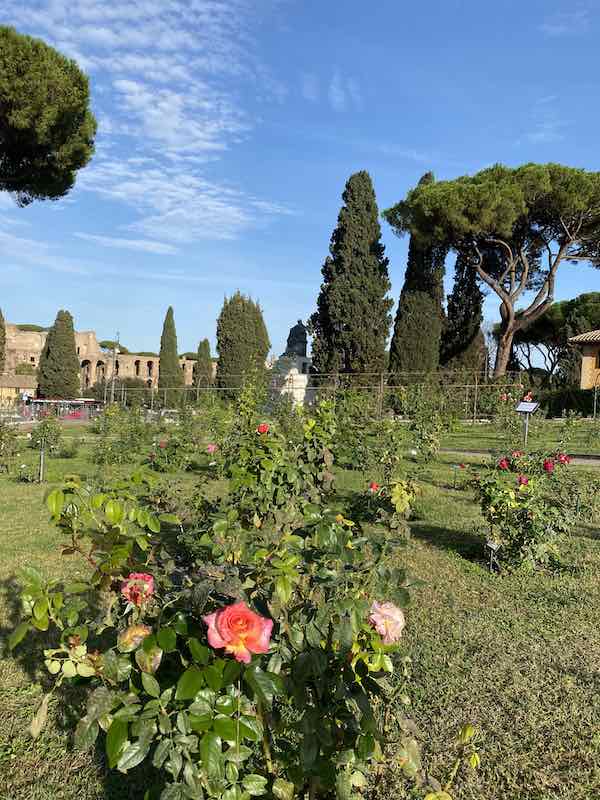
Bocca della verità’
Bocca della verità is a peculiar and fin place to see in Rome, not far from the Colosseum.
The mouth is a large round sculpture of a face with a large mouth opening that is ate centre of a legend: that say that if you put your hand into it and tell a lie, the mouth will bite your hand off!
This is very much not a hidden gem since the movie a roman holiday naked it popular yet it is fun to see and if you are staying nearby and get here at a time with jic queue, worth putting the legend to the test!
Arco di Giano
Just beside the mouth of truth stands a peculiar arch called ‘arch of Janus’.
The arch has a unique boxy appearance and while it was in origin an imperial arch, during the middle ages it took the name of the God Janus, god of transitions, which is the nae by which we still know it.
The god Janus was traditionally represented as having two faces, or two fronts really, one looking ahead and one behind; the arch seems to have acquired this name as it is quadriform and therefore has two identical fronts, looking in opposite direction just like the most common iconography of the God.
Stunning terraces
Maybe the most hidden of all hidden gems near the Colosseum are the panoramic terraces of the area, perfect to catch stunning views of the area while having a drink or a meal!
Not to be missed are the panoramic terrace of Oro Bistrot, the one of Hotel Otium and the panoramic rooftop restaurant of Palazzo Manfredi, among the best terraces in Rome.
I hope you enjoyed this overview of the best things to see and hidden gems near the Colosseum and it inspired you to visit this area! Safe travels!
Hidden gems near the colosseum – pin this


